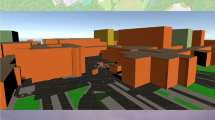Abstract
This paper presents the data collection methodology for a project aimed at creating a virtual game like experience of a historically significant location in Western Australia. The goal is less about just conveying a sense of the place but more about creating an accurate representation. Where data such as imagery and 3D models are used to represent features at the location are unavailable or approximate, they remain missing rather than filling with interpretations or interpolations. The resulting virtual environment is closer to an archeological recording or database rather than simply a 3D environment one can navigate through and experience. It is proposed that the resulting virtual environment takes on an additional believability and appears more real than if it was enhanced by arbitrary modeling and generic texturing. Presented are the data capture methods employed, the limitations encountered in conducting data capture in the field, constraints imposed by current technology and finally the remaining challenges in the various technologies employed.












Similar content being viewed by others
References
Bourke, P. D. (1989). An algorithm for interpolating irregularly-spaced data with applications in terrain modelling. In Proceedings of Pan Pacific computer conference, Beijing, China.
Bourke, P. D. (2009). iDome: Immersive gaming with the Unity game engine. In Proceedings of the computer games and allied technology 09 (CGAT09) (pp. 265–272). Research Publishing Services. ISBN: 978-981-08-3165-3.
Branwell, N. (1983). Ambisonic surround-sound technology for recording and broadcast, recording engineer/producer. http://www.ambisonic.net/branwell_arb.html.
Cakmakci, O., & Rolland, J. (2006). Head-worn displays: A review. Journal of Display Technology, 2(3), 199–216.
Efros, A. A., & Freeman, W. T. (2001). Image quilting for texture synthesis and transfer. In Proceedings of SIGGRAPH 01, Los Angeles, California.
Elberink, S. O. (2008). Problems in automated building reconstruction based on dense airborne laser scanning data. International Archives of the Photogrammetry, Remote Sensing and Spatial Information Sciences, 37(Part B3), 93–98.
Green, J. N. (1975). The VOC ship Batavia wrecked in 1629 on the Houtman Abrolhos, Western Australia. International Journal of Nautical Archaeology, 4(1), 43–63.
Green, J. N. (1989). The loss of the Verenigde Oostindische Compagnie retourschip Batavia, Western Australia 1629: An excavation report and catalogue of artefacts. British Archaeological Reports, International Series 489, Oxford.
Khodakovsky, A., Schröder, P., & Sweldens, W. (2000). Proceeding SIGGRAPH ‘00 Proceedings of the 27th annual conference on computer graphics and interactive techniques (pp. 271–278).
Krispel, U., Evers, H. L., Tamke, M., Viehauser, R., & Fellner, D. W. (2015). Automatic texture and orthophoto generation. From registered panoramic views. In The international archives of the photogrammetry, remote sensing and spatial information sciences (Vol. XL-5/W4, pp. 25–27). 3D Virtual Reconstruction and Visualization of Complex Architectures.
Reda, K., Febretti, A., Knoll, A., Aurisano, J., Leigh, J., Johnson, A., et al. (2013). Visualizing large, heterogeneous data in hybrid-reality environments. Computer Graphics and Applications, IEEE, 33(4), 38–48.
Snavely, N., Seitz, S. M., & Szeliski R. (2006). Photo tourism: Exploring image collections in 3D. In ACM Transactions on Graphics, Proceedings of SIGGRAPH 2006.
Szeliski, R. (2004). Image alignment and stitching: A tutorial. Microsoft Research Technical Report (p. 89). MSR-TR-2004-92.
Turner, D., Lucifer, A., & Wallace, L. O. (2013). Direct georeferencing of ultrahigh-resolution UAV imagery. IEEE Transactions on Geoscience and Remote Sensing, 52(5), 2738–2745.
Acknowledgments
Initial project funding from Your Community Heritage Grant awarded in 2012 to the Department of Maritime Archaeology at the WA Museum in conjunction with the Department of Fisheries, The University of Western Australia and Flinders University. Project funded by the ARC Linkage “Shipwrecks of the Roaring Forties: A Maritime Archaeological Reassessment of Some of Australia’s Earliest Shipwrecks” (Project LP130100137). Additional funding support from iVEC@UWA at The University of Western Australia. Unity3D contribution by Nick Oliver and building models by Aaron Cross.
Author information
Authors and Affiliations
Corresponding author
About this article
Cite this article
Bourke, P., Green, J. Keeping it Real: Creating and Acquiring Assets for Serious Games. Comput Game J 5, 7–22 (2016). https://doi.org/10.1007/s40869-016-0018-z
Received:
Accepted:
Published:
Issue Date:
DOI: https://doi.org/10.1007/s40869-016-0018-z




